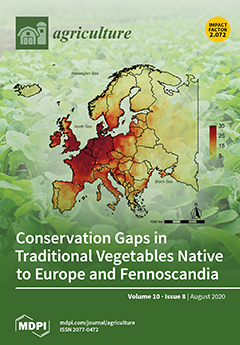In this study, a conical-cylindrical spouted bed dryer with Teflon
® beads as spouting material was used for producing powdered rosemary (
Rosmarinus officinalis L.) extract. The influence of the inlet drying gas temperature (T
gi) and the percentage ratio between the
[...] Read more.
In this study, a conical-cylindrical spouted bed dryer with Teflon
® beads as spouting material was used for producing powdered rosemary (
Rosmarinus officinalis L.) extract. The influence of the inlet drying gas temperature (T
gi) and the percentage ratio between the feed rate of concentrated liquid extract by the maximum evaporation capacity of the spouted bed (W
s/W
max) on selected physicochemical properties of the finished products were investigated. Antioxidant properties of the concentrated liquid extract and dried extracts were also evaluated by the 2.2-diphenyl-1-picrylhydrazyl radical scavenging (DPPH
•) and lipid peroxidation induced by Fe
2+/citrate (LPO) methods; and compared with the values obtained for a lyophilized extract (used as a control). Colloidal silicon dioxide (Tixosil
® 333) and maltodextrin (DE 14) at a 2:1 ratio was added to the concentrated extract before drying (4.4%
w/
w) to improve the drying performance. The drying variables W
s/W
max and T
gi have statistically significant influence on total polyphenols and total flavonoid contents of the dried powders. The concentrated extract (on dry basis—being absolute solid content) showed superior antioxidant activity (AA) compared to both the spouted bed dried and the lyophilized extracts; exhibiting IC50 values of 0.96 ± 0.02, 2.16 ± 0.04 and 3.79 ± 0.05 µg mL
−1 (DPPH
• method) and 0.22 ± 0.01, 1.31± 0.01 and 2.54 ± 0.02 µg mL
−1 (LPO method), respectively. These results of AA are comparable to values obtained for quercetin, a flavonoid compound often used as a reference standard due to its potent antioxidant activity; with IC
50 of 1.17 µg mL
−1 (DPPH
•) and 0.22 µg mL
−1 (LPO). However, the dried rosemary extracts are about 13.5 times more concentrated than the initial concentrated extract (dry weight), with a concentration of total flavonoids and polyphenols compounds ranging from 4.3 to 12.3 and from 1.2 to 4.7 times higher than the concentrated extract values (wet basis). The AA per dry product mass was thus significantly higher than the values measured for concentrated extractive solution, irrespective of some losses of AA apparently due to the drying process.
Full article





